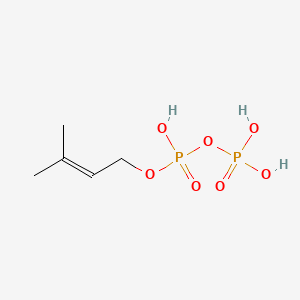| MeSH term | MeSH ID | Detail |
|---|---|---|
| Melanoma | D008545 | 69 associated lipids |
Dimethylallyl pyrophosphate
Dimethylallyl pyrophosphate is a lipid of Prenol Lipids (PR) class. Dimethylallyl pyrophosphate is associated with abnormalities such as Consumption-archaic term for TB and Wiskott-Aldrich Syndrome. The involved functions are known as Anabolism, Biochemical Pathway, Oxidation, Process and Chelating Activity [MoA]. Dimethylallyl pyrophosphate often locates in Chloroplasts, Plastids, chloroplast stroma, Cytosol and Cell membrane. The associated genes with Dimethylallyl pyrophosphate are IRF6 wt Allele and ADRBK1 gene. The related lipids are Sterols.
Cross Reference
Introduction
To understand associated biological information of Dimethylallyl pyrophosphate, we collected biological information of abnormalities, associated pathways, cellular/molecular locations, biological functions, related genes/proteins, lipids and common seen animal/experimental models with organized paragraphs from literatures.
What diseases are associated with Dimethylallyl pyrophosphate?
Dimethylallyl pyrophosphate is suspected in and other diseases in descending order of the highest number of associated sentences.
Related references are mostly published in these journals:
| Disease | Cross reference | Weighted score | Related literature |
|---|
Possible diseases from mapped MeSH terms on references
We collected disease MeSH terms mapped to the references associated with Dimethylallyl pyrophosphate
PubChem Associated disorders and diseases
What pathways are associated with Dimethylallyl pyrophosphate
Lipid pathways are not clear in current pathway databases. We organized associated pathways with Dimethylallyl pyrophosphate through full-text articles, including metabolic pathways or pathways of biological mechanisms.
Related references are published most in these journals:
| Pathway name | Related literatures |
|---|
PubChem Biomolecular Interactions and Pathways
Link to PubChem Biomolecular Interactions and PathwaysWhat cellular locations are associated with Dimethylallyl pyrophosphate?
Visualization in cellular structure
Associated locations are in red color. Not associated locations are in black.
Related references are published most in these journals:
| Location | Cross reference | Weighted score | Related literatures |
|---|
What functions are associated with Dimethylallyl pyrophosphate?
Related references are published most in these journals:
| Function | Cross reference | Weighted score | Related literatures |
|---|
What lipids are associated with Dimethylallyl pyrophosphate?
Related references are published most in these journals:
| Lipid concept | Cross reference | Weighted score | Related literatures |
|---|
What genes are associated with Dimethylallyl pyrophosphate?
Related references are published most in these journals:
| Gene | Cross reference | Weighted score | Related literatures |
|---|
What common seen animal models are associated with Dimethylallyl pyrophosphate?
There are no associated biomedical information in the current reference collection.
NCBI Entrez Crosslinks
All references with Dimethylallyl pyrophosphate
Download all related citations| Authors | Title | Published | Journal | PubMed Link |
|---|---|---|---|---|
| Brilli F et al. | Detection of plant volatiles after leaf wounding and darkening by proton transfer reaction "time-of-flight" mass spectrometry (PTR-TOF). | 2011 | PLoS ONE | pmid:21637822 |
| Nes WD | Biosynthesis of cholesterol and other sterols. | 2011 | Chem. Rev. | pmid:21902244 |
| Emma F et al. | Renal mitochondrial cytopathies. | 2011 | Int J Nephrol | pmid:21811680 |
| Tsang A et al. | Francisella tularensis 2-C-methyl-D-erythritol 4-phosphate cytidylyltransferase: kinetic characterization and phosphoregulation. | 2011 | PLoS ONE | pmid:21694781 |
| Sivy TL et al. | Evidence of isoprenoid precursor toxicity in Bacillus subtilis. | 2011 | Biosci. Biotechnol. Biochem. | pmid:22146731 |
| Bleeker PM et al. | RNA-seq discovery, functional characterization, and comparison of sesquiterpene synthases from Solanum lycopersicum and Solanum habrochaites trichomes. | 2011 | Plant Mol. Biol. | pmid:21818683 |
| Misawa N | Carotenoid β-ring hydroxylase and ketolase from marine bacteria-promiscuous enzymes for synthesizing functional xanthophylls. | 2011 | Mar Drugs | pmid:21673887 |
| Du C et al. | A mutation in the UBIAD1 gene in a Han Chinese family with Schnyder corneal dystrophy. | 2011 | Mol. Vis. | pmid:22065921 |
| Sun Y et al. | Pyrosequencing of the Camptotheca acuminata transcriptome reveals putative genes involved in camptothecin biosynthesis and transport. | 2011 | BMC Genomics | pmid:22035094 |
| Battilana J et al. | Functional effect of grapevine 1-deoxy-D-xylulose 5-phosphate synthase substitution K284N on Muscat flavour formation. | 2011 | J. Exp. Bot. | pmid:21868399 |
| Zeng Y et al. | A proteomic analysis of the chromoplasts isolated from sweet orange fruits [Citrus sinensis (L.) Osbeck]. | 2011 | J. Exp. Bot. | pmid:21841170 |
| Muraguchi T et al. | Polished rice as natural sources of cancer-preventing geranylgeranoic acid. | 2011 | J Clin Biochem Nutr | pmid:21765600 |
| Hao da C et al. | The first insight into the tissue specific taxus transcriptome via Illumina second generation sequencing. | 2011 | PLoS ONE | pmid:21731678 |
| Tang Q et al. | An efficient approach to finding Siraitia grosvenorii triterpene biosynthetic genes by RNA-seq and digital gene expression analysis. | 2011 | BMC Genomics | pmid:21729270 |
| Okada K | The biosynthesis of isoprenoids and the mechanisms regulating it in plants. | 2011 | Biosci. Biotechnol. Biochem. | pmid:21737944 |
| Nair SC and Striepen B | What do human parasites do with a chloroplast anyway? | 2011 | PLoS Biol. | pmid:21912515 |
| Schmidt A et al. | Induction of isoprenyl diphosphate synthases, plant hormones and defense signalling genes correlates with traumatic resin duct formation in Norway spruce (Picea abies). | 2011 | Plant Mol. Biol. | pmid:22002747 |
| Meier S et al. | A transcriptional analysis of carotenoid, chlorophyll and plastidial isoprenoid biosynthesis genes during development and osmotic stress responses in Arabidopsis thaliana. | 2011 | BMC Syst Biol | pmid:21595952 |
| Sui C et al. | Transcriptome analysis of Bupleurum chinense focusing on genes involved in the biosynthesis of saikosaponins. | 2011 | BMC Genomics | pmid:22047182 |
| Jang HJ et al. | Retinoid production using metabolically engineered Escherichia coli with a two-phase culture system. | 2011 | Microb. Cell Fact. | pmid:21801353 |
